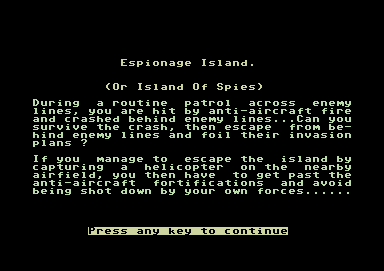Retro Replay Review
Gameplay
Espionage Island places you directly into the pilot’s seat with a minimalist, text-driven interface. From the moment your plane is hit and starts descending, every action hinges on typing the right combination of verbs and nouns. You’ll start by issuing commands like “steady controls” or “pull up” to stabilize the aircraft. This simplicity belies the depth of decision-making the game demands, as each command can mean the difference between survival and a premature crash landing.
(HEY YOU!! We hope you enjoy! We try not to run ads. So basically, this is a very expensive hobby running this site. Please consider joining us for updates, forums, and more. Network w/ us to make some cash or friends while retro gaming, and you can win some free retro games for posting. Okay, carry on 👍)
Once on the ground, the focus shifts to exploration and infiltration. You’ll need to carefully navigate the dense jungle terrain toward the enemy stronghold, issuing commands such as “move north” or “climb tree” to advance. There is no visual map, so memorization and note-taking are useful tactics. The text parser understands a surprisingly wide array of verbs, allowing you to interact with the environment in creative ways—“inspect wreckage” might uncover useful items, while “listen” can reveal patrolling guards.
Combat and evasion rely entirely on textual cues: spotting an enemy patrol triggers a “hide” command, while encountering a locked door requires “use key” or “pick lock.” Later, when you’ve secured the critical intelligence, the stakes escalate as you attempt to return disguised. The game cleverly introduces friendly fire hazards—if you don the enemy uniform but fail to specify “undercover move,” your own side may open fire. Timing and precision in your commands are paramount.
The lack of visual feedback shifts the challenge to puzzle solving and resource management. You’ll scavenge ammunition, ration food, and decide whether to risk confrontation or slip past guards unseen. Every action consumes time, and the game simulates enemy patrol schedules, adding tension to your every move. While the interface is stark, the gameplay loop of exploration, strategy, and stealth creates a compelling espionage experience.
Graphics
In Espionage Island, graphics are entirely absent—there are no images, no sprites, and no animations to accompany your mission. All information is conveyed through descriptive text, leaving visualization to your imagination. This design choice harks back to early interactive fiction titles and focuses attention on storytelling and problem-solving rather than visual spectacle.
Without graphical aids, the game’s success hinges on the quality of its descriptions. Fortunately, the text is concise yet evocative: jungle foliage rustles in your ears, the stronghold’s guards march in disciplined formation, and the rumble of distant artillery keeps you on edge. These sensory details compensate for the lack of visuals, allowing players to construct mental images of the world around them.
The absence of graphics also streamlines performance. Espionage Island loads instantly, runs on virtually any modern system, and requires minimal disk space. For players who prioritize fast, distraction-free gaming sessions, this minimalist approach can be highly appealing. It also preserves the purity of the puzzle experience, since there’s no temptation to rely on visual cues rather than textual clues and logical deduction.
That said, players accustomed to modern AAA visuals may find the no-graphics approach off-putting. If you’re seeking dynamic environments, character models, or cutscenes, Espionage Island deliberately forgoes these in favor of pure interactive fiction. Your enjoyment will depend on how much you value narrative immersion and cerebral challenges over graphical fidelity.
Story
Espionage Island unfolds a tense Cold War–style narrative wrapped in secrecy and subterfuge. You play as a lone operative dispatched on reconnaissance to a remote enemy enclave. The initial thrill of a daring aerial mission is shattered when anti-aircraft fire sends you plummeting toward the island, setting the stage for a gripping tale of survival and espionage.
As you piece together the fallen aircraft’s fragments and navigate through dense foliage, the story advances through atmospheric text descriptions. You’ll uncover clues hinting at a hidden intelligence cache: encrypted documents, coded radio transmissions, and guarded vaults. Each discovery deepens the plot, revealing your adversary’s broader schemes and heightening the urgency to escape with the intel.
The narrative takes a clever turn when you secure the data and must exfiltrate by donning an enemy uniform. This twist adds layers of tension—will your disguise hold up under scrutiny, or will friendly forces mistake you for the enemy? The stakes are clear: proceed too overtly, and you risk capture; linger too long, and the enemy may realize the breach. The story’s pacing maintains a steady pulse, culminating in a race against time to reach your aircraft carrier.
Although the tale is conveyed entirely through text, the writing crafts a vivid sense of place and purpose. The sparse prose keeps the focus on high-stakes decisions rather than ornate descriptions. For fans of espionage thrillers and command-line adventures, the storyline provides a satisfying arc from crash landing to daring escape.
Overall Experience
Espionage Island offers a unique blend of text-based strategy and stealth-focused gameplay. Its throwback interface may feel foreign to those used to graphical user interfaces, but it delivers a cerebral, story-driven journey that rewards careful observation and inventive problem-solving. Each setback encourages you to rethink your tactics, while each successful infiltration feels hard-earned.
The game’s minimalist presentation is a double-edged sword. On one hand, you benefit from rapid startup times, deep textual immersion, and unrestricted mental engagement. On the other hand, modern players seeking audiovisual flair may find the lack of graphics and sound limiting. Your enjoyment largely depends on an appreciation for classic interactive fiction and command-driven control schemes.
Replayability stems from the multiple possible paths you can take to breach the stronghold and exfiltrate. Experimenting with different disguises, routes, and command sequences can yield varied outcomes. While the core mission remains the same, subtle changes in your approach can produce fresh challenges on subsequent playthroughs.
Overall, Espionage Island stands out as a thoughtfully designed text adventure that captures the tension and intrigue of a high-stakes covert operation. It’s best suited for players who relish puzzle-based gameplay and immersive storytelling without reliance on graphics. If you’re drawn to strategic planning, stealth mechanics, and narrative depth, this game offers a compelling journey into the heart of enemy territory.
 Retro Replay Retro Replay gaming reviews, news, emulation, geek stuff and more!
Retro Replay Retro Replay gaming reviews, news, emulation, geek stuff and more!









Reviews
There are no reviews yet.